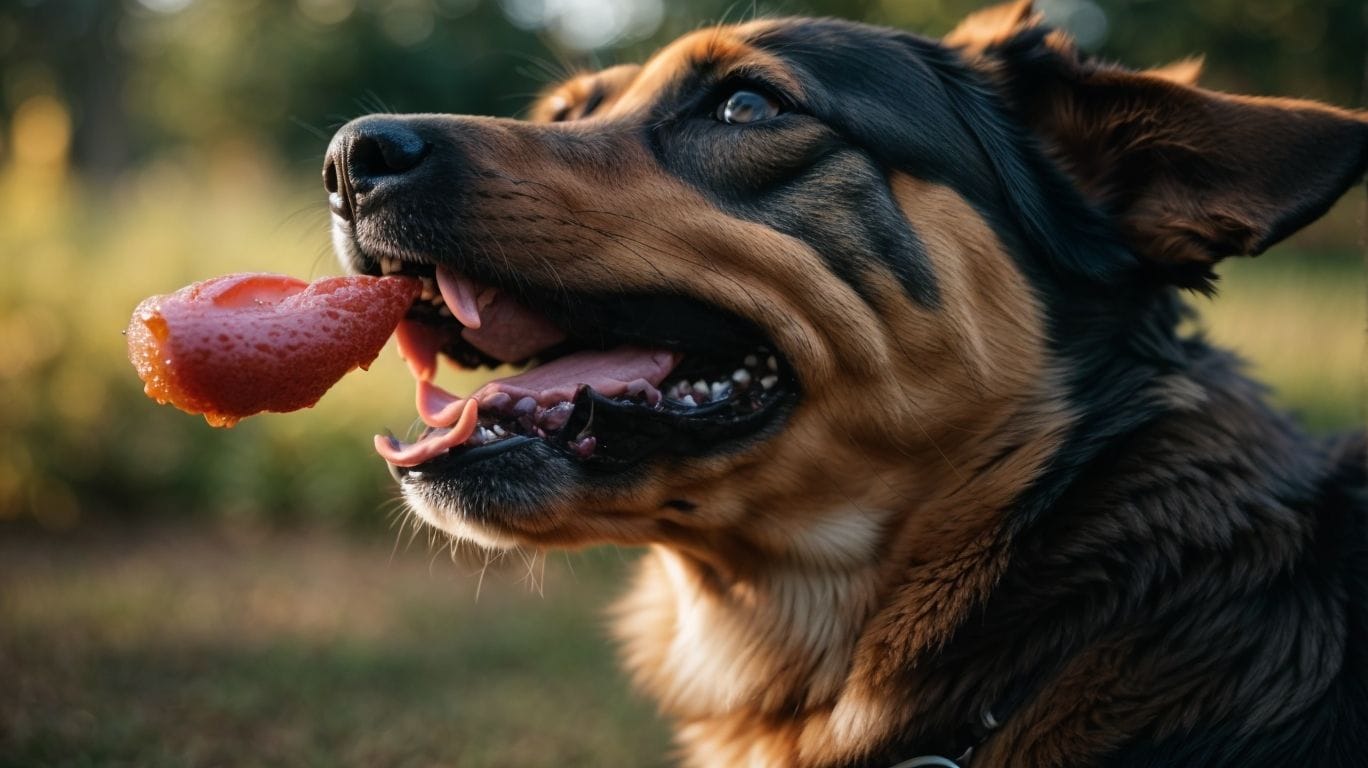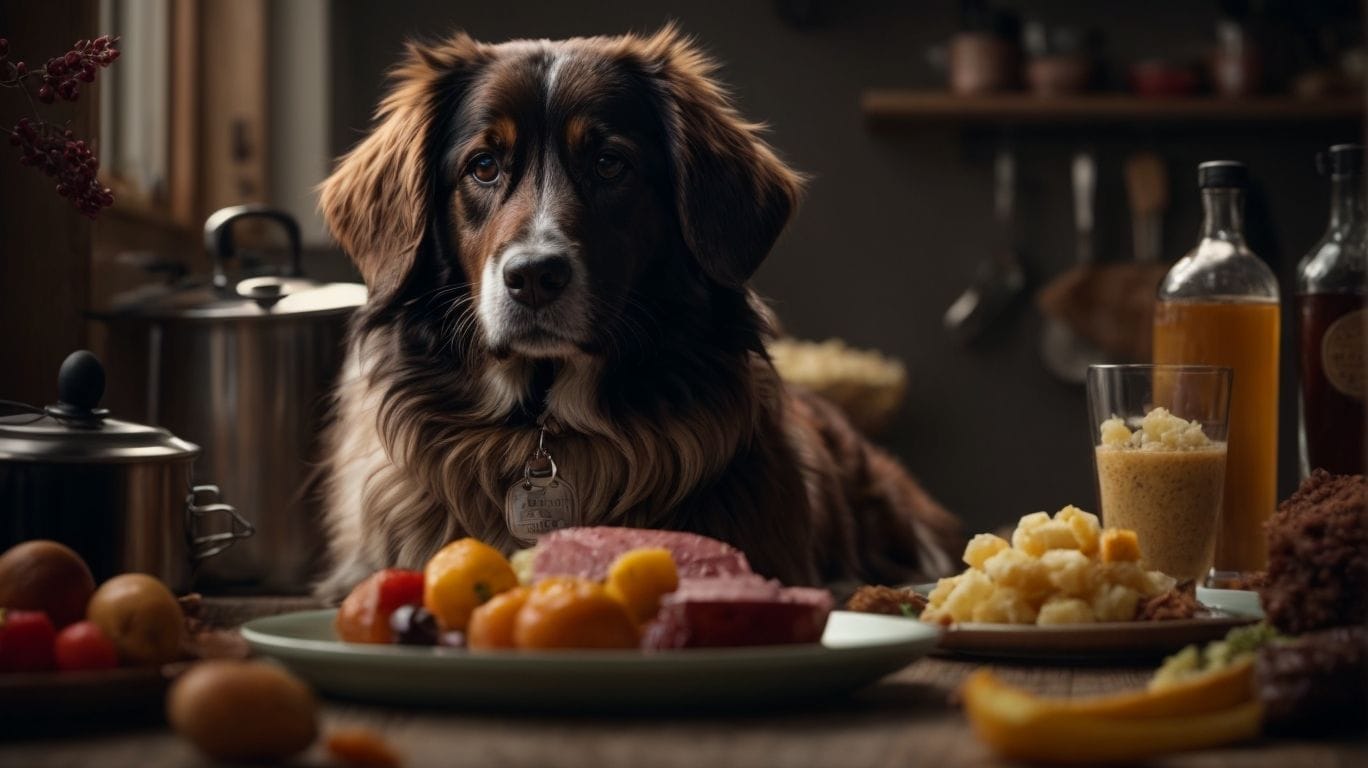Dogs, known for their sense of smell and love for food, have often left us wondering about their sense of taste. Understanding their taste preferences and how they experience food can provide valuable insight into their eating behaviors and preferences. Let’s delve into the world of a dog’s sense of taste.
To comprehend a dog’s sense of taste, it is essential to understand how taste works in humans. Humans have taste buds located on the tongue that can detect five primary tastes: sweet, salty, sour, bitter, and umami. These taste buds send signals to the brain, which interprets and identifies the flavors.
But do dogs have the same taste buds as humans? Research suggests that dogs’ taste buds are not the same as humans. Dogs have far fewer taste buds and cannot detect certain flavors like sweetness. However, they compensate for this with their exceptional sense of smell.
While dogs may not experience tastes like ours, they can still taste and differentiate various flavors. The taste buds in dogs allow them to detect basic tastes such as sweet, salty, sour, and bitter. This ability helps them evaluate and enjoy different food flavors to some extent. The sense of taste also affects a dog’s eating behavior.
Factors such as scent, texture, temperature, and familiarity also influence a dog’s food preferences. Dogs rely heavily on their sense of smell to identify and enjoy their food. The texture of the food, whether it’s wet, dry, soft, or crunchy, can also impact their preferences. Dogs may have individual preferences based on their experiences and familiarity with certain flavors.
Understanding a dog’s taste preferences can help them select appropriate food options and satisfy their palates. While dogs generally prefer meaty flavors, they can also enjoy other tastes based on individual preferences. Sweet and salty flavors are not as pronounced for dogs as for humans. However, bitter and sour flavors may be more detectable to them due to their survival instincts.
To determine your dog’s taste preferences, consider observing their reactions and preferences towards different flavors and food types. Experiment with different options and observe their preferences to cater to their tastes effectively.
By exploring the world of a dog’s sense of taste, we can better understand their preferences and provide them with enjoyable eating experiences.
“
Key takeaways:
- Dogs have taste buds: While dogs may not taste food in the same way as humans, they do have taste buds that allow them to perceive different flavors.
- Dogs have preferences: Dogs can detect sweet, sour, bitter, salty, and meaty flavors. They may have individual preferences for certain flavors, which can influence their food choices.
- Scent plays a key role: A dog’s sense of smell greatly influences their perception of food. They rely heavily on scent to determine the desirability of food, sometimes even more than taste.
Understanding the Sense of Taste in Dogs

Photo Credits: Petnarnia.Com by Zachary Rodriguez
Understanding the sense of taste in dogs is crucial to comprehending their food preferences and meeting their nutritional needs. Dogs, having fewer taste buds than humans, possess a less refined sense of taste. However, they are still capable of distinguishing between various tastes, such as sweet, salty, sour, and bitter. When enjoying their food, dogs heavily rely on their sense of smell. Having an understanding of these factors can assist pet owners in selecting the appropriate food and treats for their dogs, ensuring a healthy and satisfying eating experience.
How Does the Sense of Taste Work in Humans?
The sense of taste in humans is a complex process involving taste buds, taste receptors, and the brain. Taste buds are small structures located on the tongue that contain taste receptors. These receptors detect five basic tastes: sweet, sour, salty, bitter, and umami. When food or drink enters the mouth, molecules bind to these taste receptors, sending signals to the brain. The brain interprets these signals, allowing us to perceive and differentiate flavors. Genetics, age, and individual preferences can also influence how we perceive taste. Understanding how taste works in humans helps us appreciate the variety and enjoyment of different foods.
Do Dogs Have the Same Taste Buds as Humans?
Do dogs have the same taste buds as humans?
Dogs do not have the same taste buds as humans do. While humans have approximately 9,000 taste buds, dogs only have around 1,700. This is why their sense of taste is generally less developed than ours. Dogs prefer meaty flavors because their taste buds are more sensitive to savory tastes. They cannot taste sweetness, which humans can detect. It’s important to keep in mind that dogs rely more on their sense of smell rather than taste when it comes to food preferences. Fun fact: Dogs have an amazing olfactory system that is hundreds of times more powerful than ours!
Can Dogs Taste Food?

Photo Credits: Petnarnia.Com by Carl Harris
Yes, Can dogs taste food just like humans? They have taste buds on their tongues that allow them to detect different flavors. Their sense of taste is not as developed as ours. While humans have around 9,000 taste buds, dogs only have around 1,700. This means they may not experience flavors with the same intensity or complexity as we do. Despite this, dogs Can still differentiate between tastes, such as sweet, sour, salty, and bitter. So, the next time you share a treat with your furry friend, remember they can taste and enjoy their food.
What Are the Different Tastes Dogs Can Detect?
Dogs have a unique ability to detect different tastes that may not be the same as humans. They possess fewer taste buds than us, but their sense of taste is still very much present. Dogs can perceive a range of flavors, including sweet, salty, sour, and bitter. However, the level of sensitivity to these tastes can vary among individual dogs. It is interesting to note that dogs generally have a strong inclination towards meaty flavors, which aligns with their instinctive carnivorous nature. Additionally, some dogs may have a heightened sensitivity to bitter tastes, which serves as a protective mechanism to prevent them from consuming potentially harmful substances. Having a solid understanding of the tastes that dogs can detect is highly important when selecting suitable and enjoyable food options for them.
Do Dogs Enjoy the Taste of Food?
Do dogs enjoy the taste of food? Certainly, their enjoyment of food is evident in their behavior and reactions.
- Increased appetite: Dogs will eagerly approach their food and eat it enthusiastically when they enjoy the taste.
- Tail wagging: A happy and content dog will often wag its tail while eating, indicating enjoyment.
- Licking their lips: Dogs may lick their lips after eating as a sign of satisfaction and enjoyment.
- Search for more: If a dog finishes its food quickly and looks for more, it suggests it enjoyed the taste.
- Obedience during mealtime: Dogs that listen and respond well are likely enjoying the taste of their food.
How Does the Sense of Taste Impact a Dog’s Eating Behavior?
The sense of taste plays a significant role in a dog’s eating behavior, impacting their food preferences and consumption patterns. How does the sense of taste impact a dog’s eating behavior? Dogs possess taste buds that can detect various flavors, although their senses of taste are not as advanced as those of humans. They demonstrate higher sensitivity to tastes like meaty flavors and lower sensitivity to others, such as bitter flavors. Food taste can influence a dog’s appetite and willingness to eat, as their preferences for specific flavors contribute to their enjoyment of meals. By understanding a dog’s taste preferences, pet owners can provide appealing and satisfying food.
Factors That Influence a Dog’s Food Preferences

Photo Credits: Petnarnia.Com by Robert White
We have ever wondered why some dogs are picky eaters while others will devour anything in sight. In this section, we delve into the factors that influence a dog’s food preferences. From the enticing scent that can make tails wag in excitement to the way texture can either satisfy or repel their taste buds, we uncover the fascinating elements that affect what ends up in a dog’s bowl. Join us as we explore the role of temperature and familiarity in shaping a canine’s culinary choices. Prepare to be enlightened about what truly makes dogs tick when it comes to taste!
Scent
Dogs rely heavily on their sense of smell regarding food preferences, making scent a significant factor in their taste experience. Here are some key points to consider about the role of scent in a dog’s food preferences:
- The scent is crucial in attracting dogs to their food and enhancing their enjoyment.
- The strong sense of smell in dogs allows them to detect and distinguish various odors present in food.
- Familiar scents can make dogs more likely to be interested in and enjoy their food.
- Changes in scent, such as adding different ingredients or aromas, can entice or deter a dog from eating particular foods.
- The aroma of food can even elicit physiological responses in dogs, influencing their appetite and food preferences.
Understanding dogs’ sensitivity to scent can help owners select food that their furry companions find appealing, ensuring a nutritious and enjoyable dining experience.
Texture
Texture plays a significant role in a dog’s food preferences. Different textures can elicit various responses and behaviors from dogs. Here is a table that highlights the impact of texture on a dog’s taste preferences:
| Texture | Impact on Dog’s Taste Preferences |
| Soft and Smooth | Dogs may prefer foods with a soft and smooth texture as they are easier to chew and swallow. |
| Crunchy and Chewy | Many dogs enjoy foods with a crunchy or chewy texture as they provide a satisfying and engaging chewing experience. |
| Mixed Texture | Some dogs prefer foods with a combination of textures, such as kibble with soft, meaty centers, as it offers variety and stimulation. |
| Wet and Moist | Dogs may find wet or moist foods appealing due to their additional moisture content and enhanced aroma. |
For more information on the topic, please read “Do Dogs Taste Food?”
True history shares that texture is an essential aspect of a dog’s eating experience. Dogs have evolved to have a keen sense of texture, allowing them to perceive and appreciate different food textures. Understanding and meeting their texture preferences can enhance their enjoyment of meals and contribute to their overall satisfaction and well-being.
Temperature
Temperature plays a significant role in a dog’s food preferences. Dogs are more inclined to enjoy food served at an optimal temperature. They prefer food that is warm or at room temperature rather than food that is too cold or hot. Extremely hot food can burn their mouths, while cold food may not be as palatable. It is important to consider the temperature of the food when feeding dogs to ensure their comfort and enjoyment. Gradual temperature changes can also impact a dog’s perception of taste. For instance, adjusting the temperature of a hot food item gradually may enhance its flavor for the dog.
Familiarity
Smell plays a significant role in a dog’s food preferences. Dogs are more likely to enjoy foods that they are familiar with and have eaten before. This is because dogs have a stronger sense of smell and memory than their sense of taste. When a dog is introduced to a new food, they rely heavily on their sense of smell to determine if it is safe to eat. If the smell is familiar, it is more likely that the dog will enjoy the taste as well. It is important to introduce new foods gradually to ensure that dogs have a positive and comfortable experience.
| Key Factor | Explanation |
| Familiarity | Dogs prefer foods that they are familiar with and have eaten before. |
| Scent | Dogs rely on their sense of smell to determine if food is safe. |
| Texture | Food texture also plays a role in a dog’s food preferences. |
| Temperature | Some dogs prefer warm or cold foods, depending on their individual preferences. |
Do Dogs Have Preferences for Specific Flavors?

Photo Credits: Petnarnia.Com by Arthur Lopez
Have you ever wondered if dogs have preferences for specific flavors? Let’s dive into the fascinating world of canine taste buds. From meaty delights to sweet temptations, salty treats to bitter surprises, and even sour sensations, we’ll uncover the intriguing realm of flavors that spark our furry friends’ interest. Get ready to explore the gustatory preferences of dogs and discover what tantalizes their taste buds in a whole new way!
Meaty Flavors
Meaty flavors appeal to dogs due to their predatory nature and keen sense of smell.
|
|
|
|
|
To determine your dog’s taste preferences, offer a variety of meaty flavors and pay attention to their reactions. Remember to consult with your veterinarian to ensure a balanced diet for your pet.
Sweet Flavors
Sweet flavors are one of the taste preferences that dogs can naturally detect. While dogs have a lesser number of taste buds compared to humans, they are still capable of sensing various flavors, including sweet ones, to some degree. Dogs may also find pleasure in common sweet flavors, such as fruits like apples and bananas, as well as certain vegetables like carrots. It’s crucial to acknowledge that dogs possess distinct taste preferences and tolerances compared to humans. Therefore, what may taste sweet to us might not be as appealing to them. By understanding your dog’s taste preferences, you can effectively choose treats or formulate their diet to ensure they thoroughly enjoy their food.
Salty Flavors
Salty Flavors are essential for a dog’s sense of taste, and they influence their food preferences. Let’s explore the significance of these Salty Flavors for dogs:
- Dogs, just like humans, have taste buds that can detect Salty Flavors.
- Salty Flavors contribute to the nutritional value of a dog’s diet and can greatly enhance the taste of their food.
- However, an excessive intake of salt can have harmful effects on dogs, including dehydration and kidney problems.
- To ensure their well-being, it’s crucial to provide dogs with a well-balanced and moderate amount of salt in their diet.
- It’s important to note that some dog foods and treats may contain added salt to enhance the flavor. Therefore, it is essential to read labels and select products with appropriate salt levels carefully.
In an interesting historical incident from 1914, a canine named Buddy gained fame due to his love for Salty Flavors. Buddy’s owner, a sailor, accidentally dropped a bag of salted peanuts, and Buddy couldn’t resist devouring them all. This incident led to the realization that dogs prefer salty snacks, paving the way for creating dog-friendly treats with Salty Flavors. Buddy’s memorable salty adventure forever transformed our understanding of a dog’s taste preferences.
Bitter Flavors
Bitter flavors can have varying effects on dogs, with some finding them unpalatable while others may tolerate them. Dogs generally have fewer taste buds for detecting bitter flavors compared to humans. Despite this, they are still able to perceive bitterness to some extent. Here are some factors to consider regarding bitter flavors and dogs:
- Dangerous substances: Bitterness in certain foods can serve as a natural warning sign for dogs, indicating the presence of potentially harmful substances.
- Medication administration: Bitter flavors are commonly utilized in medications for dogs to discourage them from consuming them excessively or to aid in preventing accidental ingestion.
- Bitter deterrents: Some pet owners may use bitter sprays or substances on household items to discourage dogs from chewing on them.
Regarding bitter flavors, it is important to note that individual preferences can vary among dogs. If you are uncertain about your dog’s reaction to a certain bitter flavor, it is recommended to consult with a veterinarian.
Sour Flavors
Dogs can detect sour flavors, although they may not be as sensitive as humans. Dogs have fewer taste buds compared to humans, so their sense of taste is not as developed. They can still perceive the different tastes, including sour flavors, to some extent. Some dogs may prefer sour flavors, while others may not enjoy them as much. As with any flavor, it is important to consider your dog’s individual preferences. A balanced diet that includes a variety of flavors, including sour, can help keep your dog interested and satisfied with their meals.
How Can You Determine Your Dog’s Taste Preferences?

Photo Credits: Petnarnia.Com by Timothy Nguyen
Determining your dog’s taste preferences can be done by following these steps:
- Pay attention to their reaction: How can you determine your dog’s taste preferences? Observe your dog’s excitement or disinterest when presented with different food options.
- Experiment with flavors: To understand your dog’s taste preferences, offer various food options such as chicken, beef, or fish and observe which flavors they prefer.
- Please take note of breed preferences: Certain breeds may have specific taste preferences based on their ancestral diet. How can you determine your dog’s taste preferences? Research your dog’s breed to understand their potential preferences.
- Consider texture: Dogs may have preferences for crunchy or soft foods. How can you determine your dog’s taste preferences? Offer a range of textures to see what your dog enjoys.
- Consult with a veterinarian: If you are unsure how to determine your dog’s taste preferences, seek guidance from a veterinarian who can provide personalized recommendations.
Facts:
Some Facts About Do Dogs Taste Food:
- ✅ Dogs have taste buds on their tongues but fewer taste buds than humans. (Source: AKC)
- ✅ Dogs can taste sweet, sour, salty, and bitter, just like humans. (Source: AKC)
- ✅ Dogs have taste buds in the back of their throat, allowing them to taste food without chewing. (Source: AKC)
- ✅ Dogs have a weaker sense of taste for salt due to their natural diet of meat. (Source: AKC)
- ✅ Dogs prefer meat but are omnivores and can eat plants and animals. (Source: AKC)


